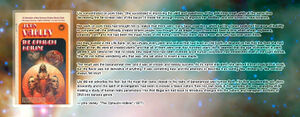Bananameat (nonfiction): Difference between revisions
(Created page with "thumb|Bananameat infographic.'''Bananameat''' is a food in John Varley's 1977 novel ''The Ophiuchi Hotline''. == Description == <blockquote> Lilo con...") |
No edit summary |
||
| (One intermediate revision by the same user not shown) | |||
| Line 13: | Line 13: | ||
Lilo did not advertise the fact, but the meat that came closest to the taste of bananameat was human flesh. Her first questionable act, done innocently and in the spirit of investigation, had been to include a tissue culture from her own body in the samples she was analyzing while making a study of human taste parameters. Her first illegal act had been to introduce changes into the culture and transplant sections of DNA into banana genes. | Lilo did not advertise the fact, but the meat that came closest to the taste of bananameat was human flesh. Her first questionable act, done innocently and in the spirit of investigation, had been to include a tissue culture from her own body in the samples she was analyzing while making a study of human taste parameters. Her first illegal act had been to introduce changes into the culture and transplant sections of DNA into banana genes. | ||
<blockquote> | </blockquote> | ||
== In the News == | |||
<gallery> | |||
</gallery> | |||
== Fiction cross-reference == | |||
* [[Gnomon algorithm]] | |||
* [[Gnomon Chronicles]] | |||
== Nonfiction cross-reference == | |||
== External links == | |||
* [] @ Wikipedia | |||
[[Category:Nonfiction (nonfiction)]] | |||
[[Category:Quotations (nonfiction)]] | |||
[[Category:John Varley (nonfiction)]] | |||
Latest revision as of 18:31, 5 November 2021
Bananameat is a food in John Varley's 1977 novel The Ophiuchi Hotline.
Description
Lilo concentrated on pork trees. She succeeded in improving the yield and sweetness of the pink inner meat, while at the same time decreasing the fat-to-lean ratio of the bacon. It made her enough money to improve her facilities, and she turned to new horizons.
Her work on pork trees had brought her to realize that there were many base organisms which had long been neglected because of inability to compete with the artificially created strains people now thought of as staple crops. There had been a time when wheat, soybeans, potatoes, corn, and rice had been the major foods of the human race. Now there was no one alive who had ever seen them.
But they existed in the Life Bank, as did virtually every plant and animal that had lived on Old Earth. It dawned on her that the food she had eaten all her life were all created plants, and that all of them were over four hundred years old. It seemed that the age of invention in plant genetics was behind her, that no totally new staple food had been invented since human civilization had established itself in the Eight Worlds. She did not bother wondering why that was; she set about to invent a new staple.
The result was the bananameat tree, and it was an instant and steady success. As its name indicated, she derived it from tropical fruit stock, but the flavor was not derivative of anything. It was something new, and the attempts to describe it as tasting "like chicken" or "like venison" always fell short.
Lilo did not advertise the fact, but the meat that came closest to the taste of bananameat was human flesh. Her first questionable act, done innocently and in the spirit of investigation, had been to include a tissue culture from her own body in the samples she was analyzing while making a study of human taste parameters. Her first illegal act had been to introduce changes into the culture and transplant sections of DNA into banana genes.
In the News
Fiction cross-reference
Nonfiction cross-reference
External links
- [] @ Wikipedia
